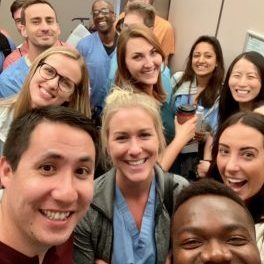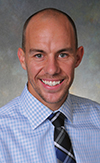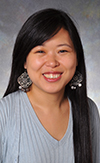
Transitional Year Residency
One-year Program for Interns
University of Minnesota Anesthesiology, Ophthalmology, and Radiology Residencies
Established in 1983
Diverse, multi-cultural patient mix
One of the largest Transitional Year programs in U.S.
Strong critical care and procedural experience
Integrated, hospital-wide EMR technology ACGME-accredited
Broad Clinical Experience with a Large Peer Cohort
For more than 30 years, the Transitional Year Program at Hennepin Healthcare has provided strong procedural and critical care training in anesthesiology, ophthalmology, and radiology.
Between 2000-2010, the program began partnerships with the University of Minnesota Radiology and Anesthesiology Residencies as a joint program. Beginning in 2021, a joint program with the University of Minnesota Ophthalmology Residency will mean that all 25 of our positions will be a part of these joint programs.
With this transformation, we will continue a broad clinical experience with appropriate oversight in a welcoming and supportive learning environment. We will also work closely with each categorical residency Program Director to ensure all residents are entering their specialty training with the skills and competencies necessary to be successful.
About Our Curriculum
Our one-year experience immerses our residents in robust, hands-on learning opportunities that build competency and confidence. All Hennepin Healthcare residents take an active role in patient care while learning from experienced specialists. Our residents work and learn side-by-side with more than 200 peers from our 15 residency and fellowship programs.
Transitional Year interns are welcomed as critical team members in each specialty they rotate through. They are afforded the same learning opportunities as the categorical residents in the departments they are working in. In addition, the TY Program itself has one afternoon per month of protected learning time. In addition to allowing time for interns to connect with each other, these sessions cover broad topics that set the stage for lifelong learning and reflection.
Nearly all rotations take place at our single-site campus, which promotes regular analysis, discussion, and collaboration with physicians in all fields. We maintain a well-earned reputation for our collegial atmosphere and supportive environment that fosters great patient care and learning.
About Our Educational Experience
Didactic Opportunities with Real-World Application
Transitional Year residents immerse themselves in a wide variety of educational conferences, simulated training, and other didactic experiences offered by each of our categorical programs. As an academic healthcare system, Hennepin Healthcare places strong institutional value on education and offers numerous opportunities for resident learning.
Quality Improvement Opportunity
Within the Transitional Year program, residents spend time in a Quality Improvement elective. During this four-week block, residents engage in independent learning and are incorporated into some of the patient safety/quality improvement work being done at Hennepin Healthcare.
Paired with interactive didactics on topics such as root cause analysis and diagnostic error, all TY interns leave with a basic understanding and appreciation for the discipline of quality improvement, which allows them to establish these skills within their own future practice.
Reflective Practice
If you’re doing it right, practicing medicine is HARD. Intern year is filled with so many new challenges that can stir up a lot of emotions. We believe there must be a space to debrief and reflect on these things, in order to grow and improve throughout your career. Over the year, we invest time and energy to create a comfortable space to share and learn from each other’s experiences. Over the past few years, our program has had stories published in medical journals and magazines, presented at city-wide story slams, and to our organization’s board.
Recent accomplishments
A Transitional Year resident’s project reviewed Hennepin Healthcare’s paging system and the issues generated from the default setting of "stat." Hennepin Healthcare’s quality committee adopted the recommendations, and the resident worked with staff to implement changes to the way Hennepin Healthcare prioritizes pages.
Another resident submitted a quality improvement project to the National Patient Safety Foundation and was selected as a Poster Session participant for the National Patient Safety Congress in Washington, D.C.
About Our Faculty
Cross-Functional Leadership
Program director, Dr. Matthew Young has been part of the Transitional Year program leadership since 2014. A recipient of the University of Minnesota Medical School’s “Exceptional Affiliate Faculty Teaching Award”, he ensures that Transitional Year residents experience the best that each discipline has to offer. Dr. Young also completed his Internal Medicine residency and Chief residency programs here at Hennepin Healthcare.
In addition to collaboration with UMN Radiology, Ophthalmology, and Anesthesiology Residency leadership, our program has a cross-functional leadership team. This is comprised of educational leaders across all key specialties and meets regularly to evaluate and improve the Transitional Year program curriculum and experience. Through this, our TY program not only improves itself but is the source of improvement for other residencies and our institution in general.
Program Leadership
Dr. Matthew Young, Program Director, Transitional Year Residency, Hennepin Healthcare
Dr. Samantha Pace, Associate Program Director, Transitional Year Residency, Hennepin Healthcare
Areas of Expertise
Our faculty share their dedication and expertise in a variety of key disciplines.
Emergency Medicine
Dr. Erin Karl
Critical Care
Dr. Heidi Erickson
General Medicine / Hospital Medicine
Dr. Matthew Young
Dr. Meghan Walsh
Dr. Samuel Ives
Dr. Mark Linzer
Internal Medicine
Dr. Rosemary Quirk
OB/GYN
Dr. Samantha Pace
Ophthalmology
Dr. Anne Abel
Pathology
Dr. Brad Linzie
Pediatrics
Dr. Sonja Colianni
Psychiatry
Dr. Bradleigh Dornfeld
About Our Rotations
Within each discipline, Transitional Year residents join their peers for rotations and didactics. Residents at Hennepin Healthcare oversee all aspects of patient care, quickly obtaining progressive responsibility and decision-making roles as their clinical and leadership skills advance. Night float is required on some rotations.
Transitional Year residents can customize their experience with 2-3 elective opportunities during the year. Popular options include infectious diseases, newborn ICU, orthopedics, pathology, quality improvement, and rheumatology.
Elective Options
- Anesthesiology
- Dermatology
- Direct Care Clinic
- Infectious Diseases
- Medical Intensive Care Unit (MICU)
- Newborn Intensive Care Unit (NICU)
- OB/Ultrasound
- Ophthalmology
- Orthopedics
- Otolaryngology
- Pathology
- Physical Medicine and Rehabilitation
- Pulmonology
- Quality Improvement
- Rheumatology
- Surgical Intensive Care Unit (SICU)
- Toxicology
A Multi-Disciplinary Approach with Numerous Elective Options
UMN Anesthesiology
| Rotation | Blocks |
|---|---|
| Internal Medicine | 1 |
| Medical ICU | 1 |
| Emergency Medicine | 2 |
| Surgery | 2 |
| OB/GYN | 1 |
| Pediatrics | 1 |
| Psychiatry | 1 |
| Anesthesia (at UMN) | 1 |
| Newborn ICU | 1 |
| Quality Improvement | 1 |
| Elective | 1 |
UMN Interventional Radiology
| Rotation | Blocks |
|---|---|
| Internal Medicine | 2 |
| Emergency Medicine | 2 |
| Surgery | 2 |
| Neurology | 1 |
| OB/GYN | 1 |
| Psychiatry | 1 |
| General Diagnostic Radiology | 1 |
| Interventional Radiology | 1 |
| Quality Improvement Elective | 1 |
| Elective | 1 |
UMN Diagnostic Radiology
| Rotation | Blocks |
|---|---|
| Internal Medicine | 2 |
| Emergency Medicine | 2 |
| Surgery | 2 |
| Neurology | 1 |
| OB/GYN | 1 |
| Psychiatry | 1 |
| Pediatrics | 1 |
| General Diagnostic Radiology | 2 |
| Quality Improvement Elective | 1 |
UMN Ophthalmology
| Rotation | Blocks |
|---|---|
| Internal Medicine | 2 |
| Surgery | 2 |
| Emergency Medicine | 1 |
| Pediatrics | 1 |
| Psychiatry | 1 |
| Acute Care Clinic | 1 |
| Ophthalmology (at Hennepin) | 2 |
| Ophthalmology (at UMN) | 1 |
| Quality Improvement Elective | 1 |
| Elective | 1 |
Elective options are broad. We are usually able to accommodate any specialty request that is a clinical specialty located at Hennepin Healthcare.
What Sets Us Apart?
Dedicated peer group
With 25 Transitional Year residents annually, our program provides a unique opportunity for teamwork, discussion, and camaraderie with other residents in similar and varied fields of study.
Patient diversity
We provide treatment to large percentages of the immigrant and underserved populations in the Twin Cities. Every day, residents care for patients from across the spectrum of ethnic and economic backgrounds, alongside interpreters, for non-English speaking patients with healthcare needs at all levels of severity.
Expertise in trauma and critical care
Transitional Year residents work in our fast-paced, high-volume Emergency Department, with responsibility for overseeing critical care, directing the initial stabilization of patients, and managing airway interventions, procedural sedation, and other key skills.
Fully integrated technology
Our curriculum utilizes the latest systems and tools, from orientation and real-life procedural training in the Interdisciplinary Simulation and Education Center to ultrasound usage across clinical areas. Hennepin Healthcare operates using EPIC electronic medical records system.
Quality Improvement focus
A broad, multidisciplinary clinical experience gives residents a broad appreciation for different ways to approach clinical care. They witness multiple examples of best practices in terms of patient safety and quality care and leave with a thorough recognition of their future specialty’s role in the entire healthcare system.
Application Requirements
Entry to this program is now through the University of Minnesota's Anesthesiology, Radiology and Ophthalmology Residencies.
Anesthesiology Residency Program
Radiology Diagnostic Residency
Radiology Integrated Residency
Ophthalmology Residency
About Our Facility
Training takes place at the HCMC campus in downtown Minneapolis. This facility spans five city blocks and houses in-patient and ambulatory services, our Level I Adult and Pediatric Trauma Center, and numerous specialty clinics. We provide the full spectrum of care for patients, from primary care to hospitalization through rehabilitation.
Our Emergency Department handles cases at all levels of severity, including day-to-day emergencies and disaster response. To serve our multi-cultural population, we operate clinics in Somali, Russian, and Spanish, and employ a staff of more than 40 full-time interpreters.




